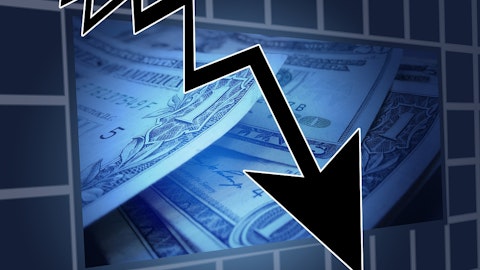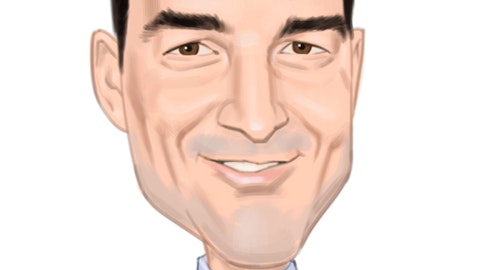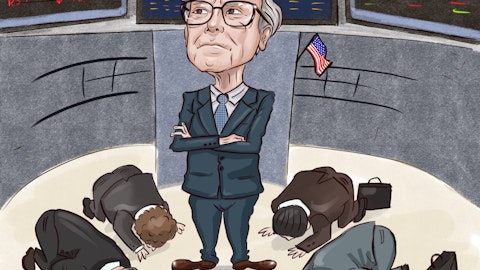Colgate-Palmolive Company (NYSE:CL) Q2 2023 Earnings Call Transcript July 28, 2023
Colgate-Palmolive Company beats earnings expectations. Reported EPS is $0.72, expectations were $0.67.
Operator: Good morning. Welcome to today’s Colgate-Palmolive 2023 Second Quarter Earnings Conference Call. This call is being recorded and is being simulcast live at www.colgatepalmolive.com. Now for opening remarks, I’d like to turn this call over to Chief Investor Relations Officer and Executive Vice President, M&A, John Faucher.
John Faucher: Thank you, Allison. Good morning, and welcome to our second quarter 2023 earnings release conference call. This is John Faucher. Today’s conference call will include forward-looking statements. Actual results could differ materially from these statements. Please refer to the Q2 2023 earnings press release and related prepared materials and our most recent filings with the SEC, including our 2022 annual report on Form 10-K and subsequent SEC filings, all available on Colgate’s website for a discussion of the factors that could cause actual results to differ materially from these statements. This conference call will also include a discussion of non-GAAP financial measures, including those identified in tables 4, 6, 7, 8 and 9 of the earnings press release.
A full reconciliation to the corresponding GAAP financial measures is included in the Q2 2023 earnings press release and is available on Colgate’s website. Joining me on the call this morning are Noel Wallace, Chairman, President and Chief Executive Officer; and Stan Sutula, Chief Financial Officer. Noel will provide you with some thoughts on our Q2 results and our 2023 outlook, and we will then open it up for Q&A. Noel?
Noel Wallace: Well, thanks, John, and good morning, everyone. So a few quick thoughts this morning on our strong quarter of top and bottom line growth and clearly along with the improved 2023 outlook we provided. On the first quarter call, you’ll recall, I highlighted three priorities for the year, driving organic sales growth as we face tougher comparisons, executing on productivity and revenue growth management to fund brand investment, while also delivering on our earnings targets, and improving our cash flow performance. While not without its challenges, in Q2, we made strong progress on all three of these. On organic sales growth, Q2 showed the strength of our global portfolio as we delivered our strongest quarterly growth on a two-year stack basis since Q3 2008, with both organic volume and pricing growth accelerating on a two-year stack basis.

Copyright: nicoletaionescu / 123RF Stock Photo
We delivered organic sales growth in all six divisions and in each of our categories grew in the mid-single digits or higher. We are laser-focused on returning to balanced organic sales growth and we believe the investments we are making, combined with easier comparisons, give us a path to improved volume growth going forward as we leverage increased brand support and innovation while still delivering profit growth. The strength of our revenue growth management efforts, combined with our progress on funding the growth, drove improvement in our gross margin both sequentially and year-over-year. Our Base Business SG&A was down 30 basis points in the quarter. A strong sales growth, lower logistics costs and the benefits of our 2022 global productivity initiative drove operating leverage even as we increased advertising spending by 20%.
Combined with our gross margin expansion, we delivered 60 basis points of operating margin expansion in the quarter. This enabled us to deliver upside versus expectations in the quarter despite continued pressure from below the line items, including the impact of higher interest rates and tax. As you’ve heard me say, it’s just virtuous combination of growth driven leverage, revenue growth management, cost containment and productivity to drive investments in capabilities and brand building which drove the strong quality of this quarter’s results. We believe it also lays the groundwork for our performance across the balance of the year and into the future. And finally, our strong cash flow performance continued in the quarter, which is helping us offset some of these below the line headwinds.
Free cash flow was up more than 50% in the quarter and is more than up — up more than 80% year-to-date through net income growth and improved working capital performance and pleasingly, particularly in inventories and payables. So I’m pleased with how we started the year, but I’m also well aware of the challenges and uncertainty ahead of us. Our goal is to deliver consistent, high quality compounded top and bottom line growth to drive shareholder value. And I believe Colgate-Palmolive has the brands, the global footprint and the people to deliver. So with that, I’ll turn it over to the Q&A.
See also 11 Best Under The Radar Stocks To Buy and Dividend Growth Stocks: 25 Aristocrats.
Q&A Session
Follow Colgate Palmolive Co (NYSE:CL)
Follow Colgate Palmolive Co (NYSE:CL)
Operator: Thank you. We will now begin the question-and-answer session. [Operator Instructions] And Our first question today will come from Dara Mohsenian of Morgan Stanley. Please go ahead.
Dara Mohsenian: Hey. Good morning, guys.
Noel Wallace: Hi, Dara (ph).
Dara Mohsenian: So another impressive quarter of organic sales growth. And as you mentioned, the CAGR is accelerated on a multiyear basis, but it was driven by pricing more than entirely. And obviously, from here, we’re going into a period where we’re cycling higher pricing. So can you just talk about, conceptually at a high level, how you think about the balance of organic sales growth going forward, level of visibilities that volume can come back as pricing drops off? And maybe within that question also, if you could just touch on the global Oral Care share and the performance in the quarter and prospects going forward, that would be helpful also. Thanks.
Noel Wallace: Sure. Thanks, Dara. So let me go back to a couple of the comments I made in my opening statement and really talk about how we’re trying to work to improve the quality of the P&L, which puts us in the best position to drive compounded long-term balanced growth top and bottom line, which is what we’ve been talking about for quite some time. As you know, we’re coming out of what has been the worst raw material environment in decades. So our plan is with the combination of the revenue wealth management we talked about and the discipline that we’re putting across the company in that area, more pricing and productivity, we can restore our gross margins and that’s been the key focus. We believe that if we exit this type of environment with a structurally lower gross margin, you’re going to be in a hole that’s very difficult to dig yourself out of in the future, particularly because you need the gross margin to fund the investment in capabilities and the brand building, which you certainly saw in the quarter.
We want to grow margins while still investing behind our brands and sustain a consistent organic sales growth, which we’re clearly demonstrating. The key to do is getting pricing in the P&L. We certainly focused our teams on the ground in that area because the depth and duration of this cost inflation that we’re experiencing has been an issue and you simply can’t do it with one round of pricing. It needs to be consistent and deliberate and purposeful. And now as we look at cost inflation slowing overall, there are still places where we see margin pressure. So we — of course, we need to take additional pricing, and this has had an impact on the volume. Maybe a couple of examples. China is a good example. We’ve taken pricing on our Hawley & Hazel joint venture in order to improve profitability long-term to drive the necessary investments in digital, the premium innovation required in that market and a continued shift to e-commerce.
And as you know, China is a very difficult market in which to take pricing. And in the short term, that hasn’t — that’s had an impact on our volume through lower promotions and wholesaler inventories as we look to set the new pricing in the market. But the long-term implications of not restoring margins are more problematic. I’d go on to North America as well, where we’re working to improve the health of our business and our brands through shifting more consistent brand support from above the net revenue line to obviously into margin expansion. This will improve health of our brands and our P&L. We’re seeing this play out in our non-promoted share, which is growing, which is a healthy way to grow the business. In the short term, was the volume impact from reduced promotions more than we expected?





